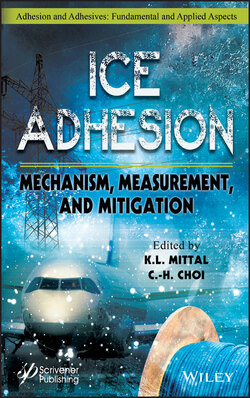Читать книгу Ice Adhesion - Группа авторов - Страница 42
2.4 Summary
ОглавлениеIn this chapter, the theoretical modeling framework of classical nucleation theory has been outlined. The fundamentals are applicable for predicting both water and ice nucleation processes due to the same controlling mechanism of embryo formation. In simple terms, the phase transition occurs when an embryo (cluster) of new phase forms with a critical size, which is related to a maximum energy of embryo formation as “nucleation barrier”. From classical theory, a temperature-dependent nucleation rate can be expressed:
The model demonstrates the relevant parameters of nucleation, including the nucleation barrier ΔG*, and the dynamical pre-factor J0 which depends on the diffusion coefficient for nucleation.
Classical nucleation theory provides a rational guideline to spatially control the heterogeneous nucleation of water and ice on solid surfaces. By altering the structural topography and intrinsic wettability on surfaces, the location and movement of nucleating water embryos can be manipulated. One example is enabling the condensate to form the suspended Cassie droplet during condensation. Such droplet wetting morphology can enhance the continuous condensation rate, while also suppressing ice nucleation in condensed water when the surface is in a supercooled condition. However, the understanding of interfacial properties for ice nuclei on solid surfaces remains inconclusive. Recent investigations on anti-freeze proteins and ionic surfaces indicate a strong influence of interface effects on the nucleation. These unresolved questions imply that more work needs to be conducted on the exact molecular mechanism underlying the nucleation processes. The answers will direct the future strategies for enhanced condensation and anti-icing applications.
